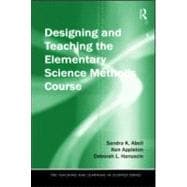
Note: Supplemental materials are not guaranteed with Rental or Used book purchases.
Purchase Benefits
What is included with this book?
| Preface | p. ix |
| Acknowledgments | p. xii |
| Introduction | p. 1 |
| Theoretical, Contextual, and Pedagogical Foundations for the Elementary Science Methods Course | p. 9 |
| Perspectives on Science Teacher Learning | p. 11 |
| Views about Learning and Teaching | p. 12 |
| Ideas about Knowledge | p. 13 |
| Learning Theories | p. 16 |
| A View of Learning | p. 24 |
| An Example Application to a Science Methods Course | p. 32 |
| Conclusion | p. 34 |
| More to Explore | p. 35 |
| References | p. 35 |
| The Context for Elementary Science Teacher Preparation | p. 37 |
| Who is Responsible for Educating Elementary Science Teachers? | p. 37 |
| The Policy Context: Goals and Standards for Elementary Science Teacher Education | p. 38 |
| The Program Context: Elementary Teacher Education | p. 40 |
| The Program Context: Science Courses | p. 44 |
| The Program Context: Field Experience and Partnerships with Local Schools | p. 46 |
| Conclusion | p. 46 |
| More to Explore | p. 47 |
| References | p. 48 |
| Orientations to Teaching Science Teachers | p. 50 |
| Introduction | p. 50 |
| What are Orientations to Teaching Teachers? | p. 51 |
| Some Orientations to Teaching Science Teachers | p. 51 |
| The Reflection Orientation and the Science Methods Course | p. 54 |
| Conclusion | p. 59 |
| Tools for Teaching Elementary Science Methods | p. 60 |
| References | p. 63 |
| Understanding the Elementary Science Methods Student | p. 65 |
| Introduction | p. 65 |
| Prospective Teachers as Learners | p. 66 |
| Prospective Teachers' Knowledge for Science Teaching | p. 69 |
| Understanding Your Methods Students | p. 74 |
| Conclusion | p. 77 |
| More to Explore | p. 78 |
| References | p. 78 |
| Curriculum and Resources for Elementary Science Teacher Education | p. 80 |
| Aims and Goals for the Science Methods Course | p. 81 |
| The Methods Course Curriculum-What to Include? | p. 82 |
| Selecting Resources and Materials | p. 91 |
| Facilities and Equipment | p. 95 |
| Communicating Your Expectations to Students: The Course Syllabus | p. 98 |
| Conclusion | p. 98 |
| Tools for Teaching the Elementary Science Methods Course | p. 100 |
| More to Explore | p. 101 |
| References | p. 101 |
| Instructional Strategies for the Elementary Science Methods Course | p. 102 |
| Aspects of PCK Pertinent to this Chapter | p. 103 |
| Your Orientation to Learning and Teaching | p. 104 |
| Enviroment | p. 106 |
| General Pedagogy | p. 107 |
| Teaching Models | p. 125 |
| Teaching How to Plan | p. 133 |
| Conclusion | p. 135 |
| More to Explore | p. 136 |
| References | p. 136 |
| Assessment Strategies for the Elementary Methods Course | p. 138 |
| Purposes and Examples of Assessment in the Elementary Science Methods Course | p. 139 |
| Principles of Effective Assessment | p. 144 |
| Scoring and Grading Assignments | p. 152 |
| Putting it All Together: Designing a Methods Course Assignment | p. 157 |
| Conclusion | p. 161 |
| Tools for Teaching Elementary Science Methods | p. 162 |
| More to Explore | p. 168 |
| References | p. 168 |
| Field Experiences in Elementary Science Methods | p. 171 |
| Benefits of Field Experiences | p. 172 |
| Addressing Challenges to the Science Methods Field Experience | p. 174 |
| Various Models of Science Methods Field Experiences | p. 178 |
| Student Reflection on the Field Experience | p. 182 |
| Conclusion: Design Principles for Science Methods Field Experiences | p. 185 |
| Tools for Teaching Elementary Science Methods | p. 187 |
| References | p. 191 |
| Activities that Work for the Elementary Science Methods Course | p. 195 |
| Learning about the 5E Learning Cycle: Magnetism | p. 201 |
| Interactive Approach: Floating and Sinking | p. 218 |
| Inquiring into Guided and Open Inquiry: Insect Study | p. 233 |
| Eliciting Student Ideas: The Human Body | p. 247 |
| Using Models and Analogies: Electric Circuits | p. 255 |
| Learning about Discourse: Light and Shadows | p. 270 |
| Integrating Language Arts and Science: A Journey through the Water Cycle | p. 278 |
| Seamless Assessment: The Moon Investigation | p. 287 |
| About the Authors | p. 302 |
| Index | p. 303 |
| Table of Contents provided by Ingram. All Rights Reserved. |
The New copy of this book will include any supplemental materials advertised. Please check the title of the book to determine if it should include any access cards, study guides, lab manuals, CDs, etc.
The Used, Rental and eBook copies of this book are not guaranteed to include any supplemental materials. Typically, only the book itself is included. This is true even if the title states it includes any access cards, study guides, lab manuals, CDs, etc.